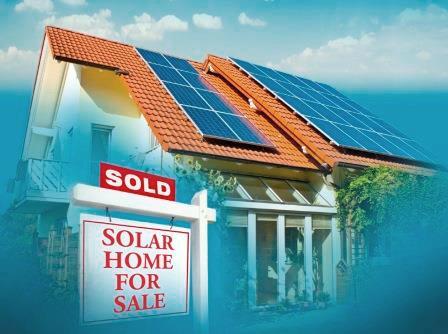Welcome to the
Run on Sun Monthly Newsletter

In this Issue: |
January, 2015
Volume: 6 Issue: 1
Top 5 Reasons You Shouldn't Wait to Go Solar
1. Minor Technology Gains Aren't Worth the WaitResearch in the solar industry is ongoing and I have no doubt that panel technology will improve. However, most changes in design and efficiency are small. And the research and development necessary to ensure the technology works in the field and not just the lab takes time. The bottom line is this: the financial value of small efficiency gains from panel improvements is outweighed by the cost of waiting. Any money you might save by installing more efficient panels is significantly less than the money you would save immediately by installing solar today. 2. Further Price Cuts Aren't Worth the WaitThe cost of solar panels has fallen tremendously the last few years—now half of what they were in 2008, and 100 times lower than they were in 1978! So, should you wait for the price to drop lower? We've actually started to see the prices of PV solar modules begin to flatten and even slightly increase since 2013. Now that demand for solar is gaining momentum, the costs will likely continue to rise to meet that demand. 3. Electric Costs Keep RisingThe rate of increase varies depending on your state and electricity source but based on the last decade you can expect around 4-5% hikes in grid electricity each year (Energy Information Administration). That means that if you invest in a solar system that meets 100% of your electricity needs today, you will fully save on this year's costs. But each year thereafter you'll save an additional 4-5% for the life of your solar system (up to 40 years). As energy prices skyrocket you can rest easy. 4. Rebates and Tax Breaks Are Going, Going...Rebates for installing solar, once as high as $4.00/Watt, have largely gone away (Pasadena being a happy, and notable, exception—see the next story!).
5. The Environment Can't WaitIf you're concerned about climate change, you know that we need to act quickly, and in any way possible to prevent overshooting the global goal of a maximum 2 degree rise over pre-industrial temperatures. The typical residential solar system, about 5 kW, cuts about 6.7 tons of carbon emissions each year (using EPA's CO2 emissions calculations). While there isn't a dollar figure attached to that, you may want to consider the larger environmental value of going solar sooner rather than later.
|
“If you're concerned about climate change, you know that we need to act quickly…”
Get your copy of
Commercial Solar:
Step-by-Step
from
Run on Sun
Founder & CEO
Jim Jenal

Now available on Amazon.com
in both
Print & Kindle versions.
Bonus - Buy the Print version…
Get the
Kindle version for Free!
Commercial Solar:
Step-by-Step
from Run on Sun
Founder & CEO
Jim Jenal

Now available on Amazon.com
in both Print & Kindle versions.
Get the Kindle version for Free!
2015 Solar Rebate UpdateSolar rebates are rapidly becoming an endangered species, but there are still a handful of refuges out there for the lucky few who reside in those areas. Here is our update on who is offering what as of January, 2015. Although there are lots of ways to approach this, we figured that the most entertaining would be to rank-order each utility in the Run on Sun service area from best to worst in terms of their rebate program (and we will toss in a handy summary chart at the end).
AnaheimAnaheim is offering some big rebate numbers, but they offer a ridiculously small window of opportunity for snagging them. Specifically, the window opened on January 15, 2015 and just two weeks later the window closed on January 29! Which means you are out-of-luck until the next window is set, whenever that may be. Until next time, here are the numbers:
Which brings us to the problem children... AzusaAzusa has a rebate program, maybe. But what it really has as of now is a waiting list. Good luck with that. Burbank Water & Power (BWP) and Glendale Water & Power (GWP)Burbank and Glendale feel like the same city so its not surprising that their local utilities seem to act in lock step. Both utilities arguably offer rebates, but unlike PWP—their more intelligent neighbor to the East—neither BWP nor GWP can figure out how to keep a rebate program open for more than a few weeks (days?) at a time. They say they are victims of their own success, but we see it as a sign of bad planning. (Oh, and don't get us started about GWP's alleged Feed-in Tariff program which after a year and a half is yet to have a single application submitted! Genius!) As for now, all the unfortunate residents of these two communities can do is wait until the new fiscal year in July and hope that some funds will be allocated. Southern California Edison (SCE)In SCE territory the party is officially over—there are no more rebate funds available, and despite the Governor's call for 50% of electricity to come from renewables by 2030, there are no moves a foot to refund the CSI program. This is unfortunate beyond the lack of funding: with the demise of the CSI rebates, so goes the CSI data since that was only gathered as part of the rebate process. As a result, we lose a major solar incentive along with a major source of market data for the largest solar market in the country! More genius! (Here's a thought: since SCE still requires us to go through the interconnection agreement process - via email - why not collect the data that way?) Los Angeles Department of Water & Power (LADWP)LADWP offers a rebate, but they have the most excruciating process ever for getting it. (Think of that wealthy Uncle who could easily help you out, but is going to make you bow and scrape before he cuts loose with some ducats, and you get the picture.) Moreover, non-residential rebates are going away in favor of the Feed-in Tariff program, but for small commercial or non-profit customers, that option simply doesn't pencil out. For those residential customers with the patience to outlast the bureaucrats, here's their rebate:
Frankly, that's just not worth the trouble. In SummarySo here's the overall results for all of these utilities: While rebates are going away, the 30% federal tax credit is still in place, and will continue through the end of 2016. Carpe diem! |
Its Official…Solar Boosts Home-Owners' Property Values!Many solar stakeholders have claimed that rooftop solar systems add to the resale value of a property. Homeowners and residential solar companies frequently tout this benefit as one of the many reasons to invest in solar even though until recently there had been little statistical evidence to support the assumption.
The team analyzed some 22,000 home sales, of which nearly 4,000 had PV rooftop solar systems (more than double the number in previous studies), in eight states over a 12-year span including the housing market boom, bust, and recovery. This is by far the largest and broadest dataset ever analyzed on the subject. Results prove that homebuyers are consistently willing to pay more for homes with host-owned solar systems—averaging about $4 per watt of PV installed—across various states, housing and PV markets, and home types. This amounts to a premium of $15,000-$20,000 for a typical rooftop system. Other important conclusions the team reaached include:
As residential solar systems become more and more common, it is important to be able to value them accurately. The evidence of the added investment value shown from this study is a critical step for the growth of residential solar. And PV premiums are obviously a benefit homeowners should consider when doing their cost-benefit analysis of going solar. Please note that this study only focused on host-owned solar, not those with leased systems. It would be interesting to see a future study that analyzed that more controversial segment of the PV market. |





